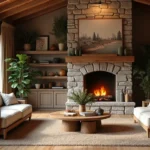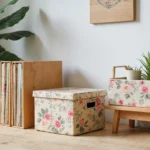When we think about transforming our home’s curb appeal, we often overlook one of the most impactful spaces – our front porch. Concrete porches offer incredible versatility and durability that can completely revolutionize your home’s entrance while staying within budget.
We’ve discovered that modern concrete isn’t just about plain gray slabs anymore. Today’s innovative techniques allow us to create stunning decorative concrete surfaces that mimic expensive materials like stone, brick, or wood – all while providing superior longevity and minimal maintenance requirements.
Whether you’re dealing with a small stoop or a sprawling wraparound porch, we’ll show you how concrete can become the foundation for your dream outdoor space. From stamped patterns and acid staining to exposed aggregate finishes, these ideas will help you create a porch that not only welcomes guests but also adds important value to your property.
Modern Minimalist Concrete Porch Designs
Embracing simplicity while maximizing visual impact, modern minimalist concrete porches create stunning architectural statements that complement contemporary home designs.
Sleek Geometric Patterns
Square and rectangular modules transform ordinary concrete surfaces into sophisticated design elements. We recommend incorporating large 24×24 inch or 36×36 inch concrete squares that create bold visual grids across your porch floor. Hexagonal patterns offer another geometric approach, with interlocking shapes that add visual interest without overwhelming the minimalist aesthetic.
Diamond configurations work exceptionally well for narrow porch spaces, drawing the eye lengthwise to make areas appear larger. We’ve seen homeowners achieve remarkable results using contrasting grout lines between geometric sections, typically in charcoal or white to enhance the pattern definition. Linear striping creates movement and direction, particularly effective when running parallel to your home’s architectural lines.
Clean Lines With Glass Railings
Frameless glass panels provide unobstructed views while maintaining safety standards required by most building codes. We suggest using tempered glass with minimum thickness of 1/2 inch for optimal durability and wind resistance. Stainless steel posts complement the glass beautifully, offering slim profiles that don’t compete with the minimalist concrete design.
Cable railing systems present another sleek option, featuring horizontal stainless steel cables stretched between posts for an industrial modern look. We recommend spacing cables no more than 4 inches apart to meet safety requirements while preserving the clean aesthetic. Powder coated aluminum frames in matte black or white create bold contrasts against light concrete surfaces.
Monochromatic Color Schemes
Pure white concrete achieves the ultimate minimalist look, especially when paired with matching white railings and trim. We achieve this using white Portland cement mixed with light colored aggregates like white sand or crushed marble. Charcoal gray surfaces offer sophisticated alternatives that hide dirt and wear better than lighter colors.
Soft beige tones warm up the space while maintaining the monochromatic principle, working particularly well with natural stone accents or wood doors. We recommend using integral color additives rather than surface stains for long lasting uniformity. Black concrete creates dramatic statements, especially effective for modern homes with dark exterior cladding or metal accents.
Stamped Concrete Porch Ideas for Added Texture
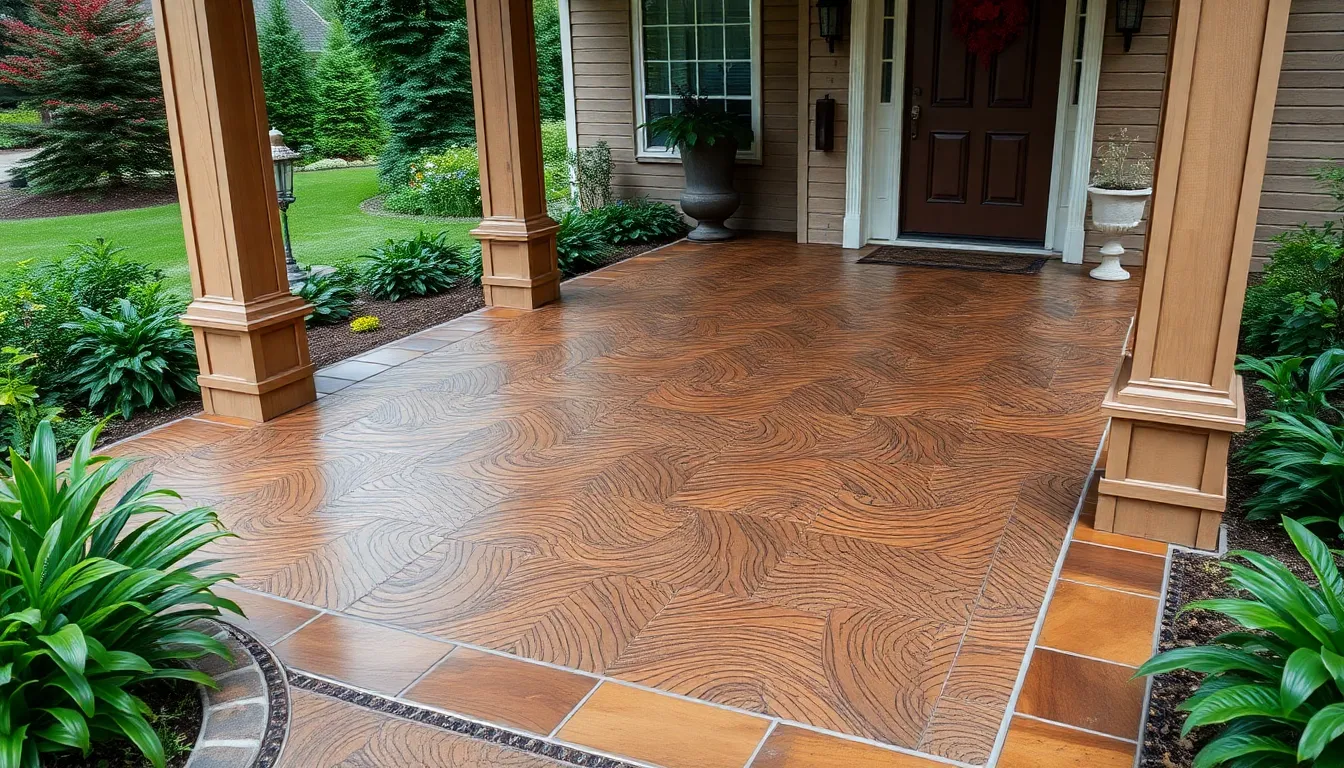
Textured stamped concrete transforms ordinary porches into stunning surfaces that provide both visual appeal and practical slip resistance. We can achieve remarkable depth and character through specialized stamping techniques that create realistic surface patterns while maintaining concrete’s inherent durability.
Wood Grain Stamped Patterns
Wood-look stamped concrete delivers the authentic appearance of natural timber without the ongoing maintenance demands. Skilled craftsmen use specialized stamps to create realistic grain patterns and plank details that closely mimic genuine wood surfaces. Staining techniques allow us to introduce color variations that replicate weathered, aged, or freshly cut wood appearances.
Advanced stamping methods can reproduce exact wood species characteristics, from the tight grain of maple to the bold patterns of oak. We achieve natural color transitions through multiple staining applications that create depth and authenticity. This approach eliminates concerns about warping, splitting, or regular refinishing while preserving wood’s timeless aesthetic appeal.
Stone and Brick Textures
Stone and brick stamped patterns offer the classic appeal of traditional masonry with concrete’s superior strength and longevity. Popular options include slate, flagstone, and brick designs that incorporate integral or surface coloring to enhance realistic appearances. We can customize layouts to complement your home’s architectural style or existing landscaping elements.
Cobblestone patterns create Old Industry charm while providing excellent traction for wet conditions. Slate textures deliver sophisticated elegance with naturally occurring color variations that mimic quarried stone. Brick stamping allows us to recreate everything from colonial running bond patterns to European herringbone layouts.
Decorative Border Designs
Decorative borders frame stamped concrete porches with visual definition that elevates the entire design. We create striking contrasts using different patterns, colors, or hand-tooled edges that separate the main surface from surrounding areas. Edge liners and saw cuts simulate chiseled stone effects or geometric designs for polished, professional results.
Border options include contrasting band patterns that outline porch perimeters or accent step edges. Compass medallions and corner details add focal points that draw attention to architectural features. We can incorporate family crests, house numbers, or custom motifs within border designs for personalized touches that reflect your unique style.
Colored Concrete Porch Solutions
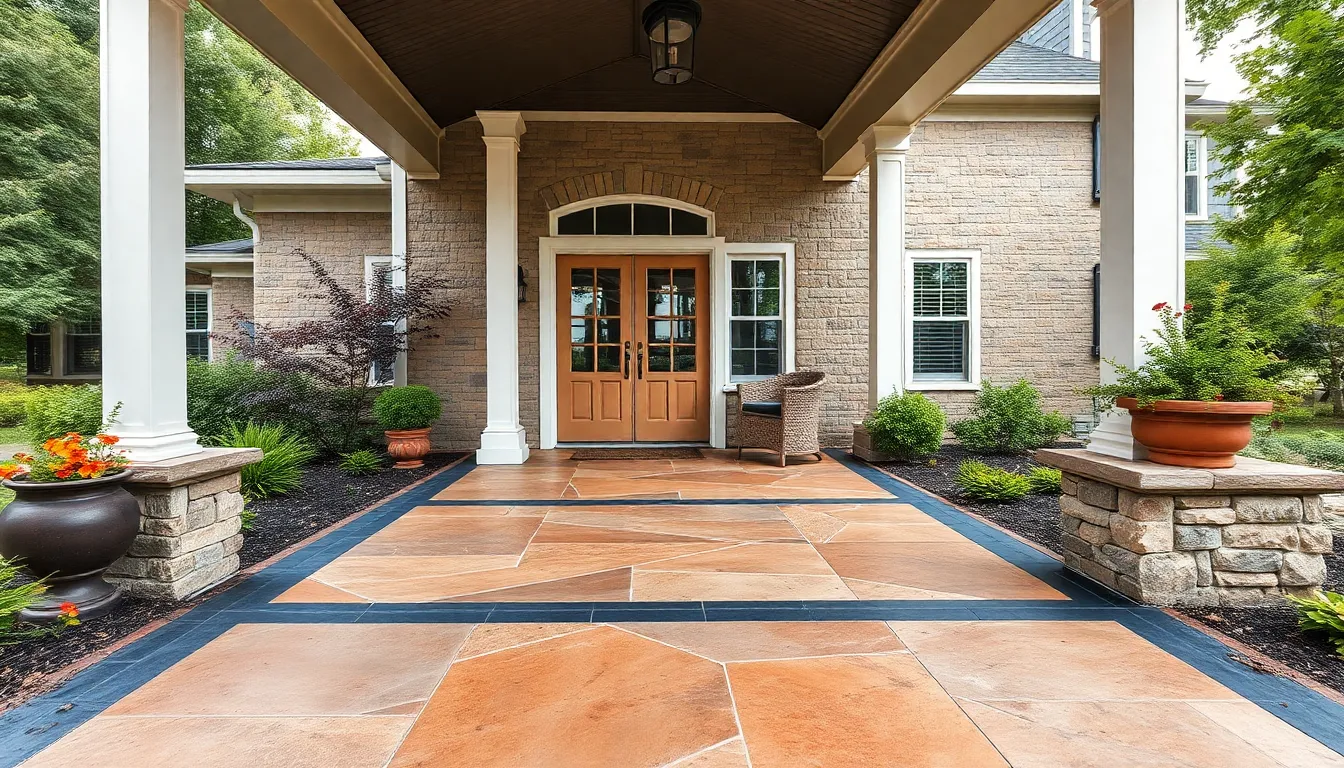
We’ll explore ever-changing color applications that transform ordinary concrete porches into stunning focal points. These colored answers offer endless customization possibilities while maintaining concrete’s inherent durability and cost effectiveness.
Earth Tone Staining Options
Natural stone mimicry becomes effortlessly achievable through earth tone staining techniques that penetrate deep into concrete surfaces. Terracotta, sandstone, and weathered granite shades create authentic appearances that complement natural landscaping elements around your porch area.
Acid staining reactions produce unique color variations that develop organically within each concrete section. These chemical processes create mottled patterns resembling natural stone formations, with colors ranging from warm amber to deep copper tones.
Wood texture replication emerges when we combine earth tone stains with stamped patterns, delivering the rich browns and tans of aged timber. Cedar, oak, and walnut color profiles provide sophisticated alternatives to traditional wood porches without ongoing maintenance requirements.
Layered staining techniques allow us to build depth through multiple color applications, creating complex finishes that shift subtly in different lighting conditions. These applications typically involve 2-3 stain layers to achieve optimal color saturation and visual interest.
Bold Accent Color Choices
Contrasting color integration transforms concrete porches through strategic placement of vibrant hues that complement your home’s exterior palette. Azure blues, forest greens, and burgundy reds create dramatic visual impact when applied to border areas or geometric sections.
Decorative tile incorporation introduces brilliant color pops through ceramic or glass tile inlays positioned at entry points or step risers. These accent elements provide opportunities to introduce Mediterranean blues, sunset oranges, or emerald greens into your porch design.
Border highlighting techniques use bold colors to define porch perimeters and create clear visual boundaries between different surface treatments. Crimson, navy, or golden yellow borders frame stamped sections while drawing attention to architectural details.
Pattern color alternation employs contrasting tones within repeating design elements, such as alternating light and dark squares in checkerboard patterns. These high contrast combinations create ever-changing visual movement across your porch surface.
Two-Tone Design Combinations
Dual staining applications combine complementary earth tones to create sophisticated color gradients that enhance architectural features. Pairing warm browns with cool grays or combining sandy beiges with slate blues produces balanced visual compositions.
Geometric pattern integration utilizes two distinct colors within stamped concrete designs to emphasize exact shapes or create optical illusions. Herringbone patterns benefit from alternating light and dark tones, while diamond shapes pop when outlined in contrasting colors.
Section color blocking divides porch areas into distinct zones using different color treatments for main surfaces versus borders or step areas. This technique works particularly well when lighter tones occupy larger areas while darker colors define edges and transitions.
Textural color variation applies different colors to various stamped textures within the same porch space, creating depth through both tactile and visual elements. Smooth areas might feature lighter tones while textured sections receive deeper, richer colors for enhanced contrast.
Concrete Porch Ideas With Built-In Features
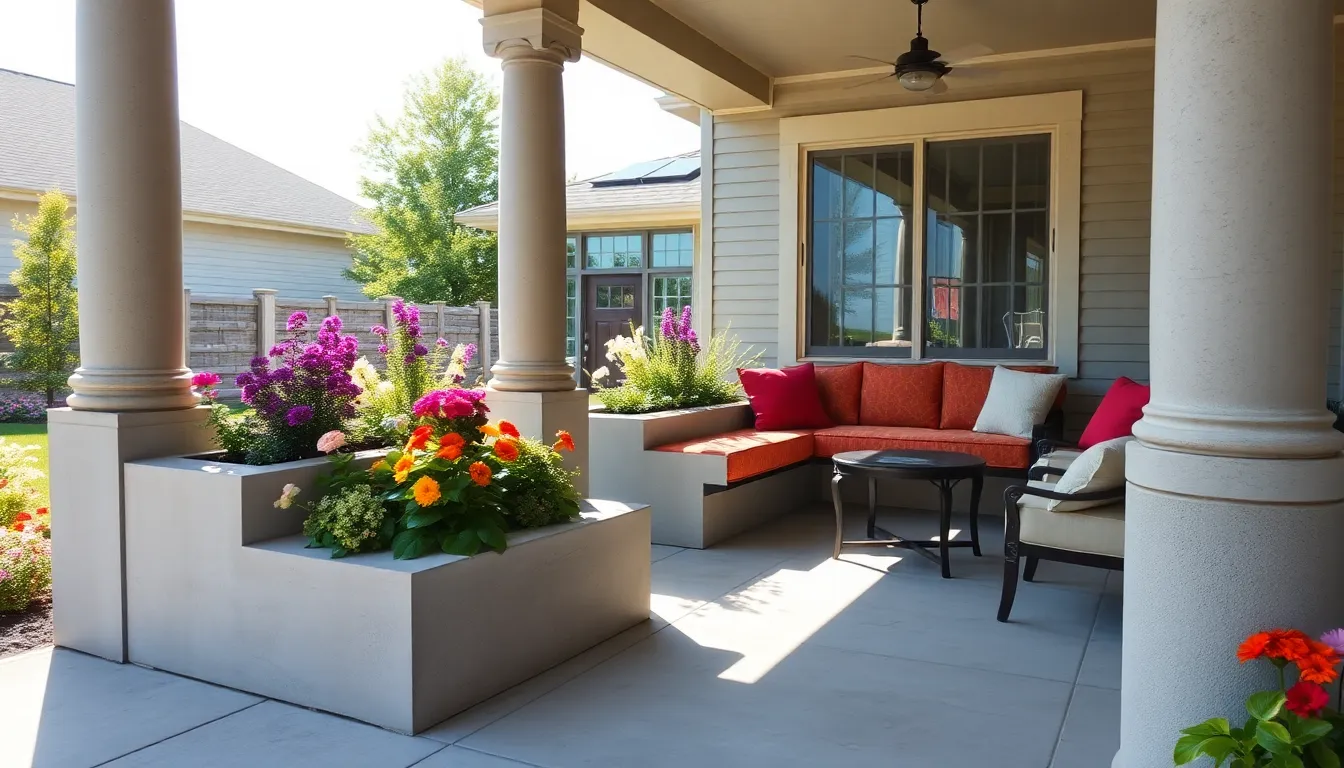
Built-in features transform ordinary concrete porches into multifunctional outdoor living spaces that combine beauty with practicality. These integrated elements eliminate the need for separate furniture while creating seamless design continuity.
Integrated Planters and Garden Beds
Incorporating planters directly into concrete porch designs creates stunning garden displays that enhance both visual appeal and property value. We can integrate these planters into porch floors or walls, allowing for creative arrangements that complement the overall architectural style.
Built-in garden beds serve dual purposes as decorative elements and functional growing spaces for herbs, flowers, or seasonal plants. These concrete planters offer superior durability compared to traditional containers and won’t crack, fade, or require frequent replacement like plastic or ceramic alternatives.
Raised planter walls double as seating areas when designed at appropriate heights, typically 18 to 24 inches. Strategic placement of these garden features helps define separate zones within larger porch spaces while providing natural privacy screens.
Built-In Seating Areas
Concrete benches represent one of the most popular built-in porch features, offering permanent seating answers that withstand weather extremes without maintenance concerns. We design these benches with integrated backrests and armrests for enhanced comfort, often adding weather-resistant cushions for additional softness.
Curved concrete seating areas create unique focal points that encourage conversation and social interaction. These flowing designs work particularly well in corner spaces or around fire pit installations, maximizing seating capacity while maintaining visual interest.
L-shaped bench configurations optimize corner spaces and accommodate larger groups during gatherings. Built-in storage compartments beneath seating surfaces provide convenient spaces for outdoor cushions, garden tools, or seasonal decorations.
Decorative Columns and Pillars
Column designs using concrete offer architectural interest while supporting porch roofs and creating defined entryways. We create these structural elements in various styles ranging from sleek modern cylinders to traditional fluted designs that complement existing home architecture.
Textured finishes applied to concrete columns enhance their visual appeal through techniques like stamping, brushing, or aggregate exposure. These surface treatments can mimic natural stone, brick, or wood grain patterns while maintaining concrete’s inherent durability advantages.
Lighting integration within decorative pillars creates dramatic evening ambiance through recessed fixtures or built-in lantern housings. Strategic column placement frames views, defines spaces, and provides mounting points for hanging plants or decorative elements that enhance the overall porch experience.
Exposed Aggregate Concrete Porch Styles

Exposed aggregate concrete transforms ordinary porches into stunning textured surfaces by revealing decorative materials mixed into the concrete. This technique creates visually appealing finishes that combine durability with sophisticated design elements.
Natural Stone Aggregate Finishes
Natural stone aggregate brings luxury and organic beauty to concrete porches through carefully selected materials like granite chips and marble pieces. These premium aggregates create sophisticated surfaces that mimic expensive natural stone installations while maintaining concrete’s practical benefits.
Granite aggregate provides exceptional durability and weather resistance with its crystalline structure reflecting light beautifully throughout the day. The varied color tones within granite chips create depth and visual interest that changes with lighting conditions.
Marble aggregate offers elegant white and cream tones that brighten porch spaces and complement traditional architectural styles. The polished finish options available with marble aggregate can range from subtle matte textures to glossy surfaces that enhance reflective qualities.
River rock aggregates introduce smooth, rounded textures that feel comfortable underfoot while providing excellent slip resistance when properly finished. These naturally tumbled stones create organic patterns that work well with industry design elements.
Finishing techniques allow customization of the final appearance through polishing levels and surface treatments. Rough finishes emphasize the natural texture of stone aggregates while polished surfaces highlight their inherent colors and patterns.
Colored Glass Aggregate Options
Colored glass aggregate transforms concrete porches into vibrant decorative features that capture and reflect light in ever-changing ways. These modern design elements add contemporary flair while maintaining practical functionality for high traffic areas.
Recycled glass chips provide eco-friendly options in jewel tones like emerald green, sapphire blue, and amber yellow that create stunning visual impact. The reflective properties of glass aggregate make porches appear larger and more luminous, especially when illuminated by outdoor lighting.
Frosted glass aggregate offers softer light diffusion compared to clear glass while maintaining color vibrancy and durability. This option works particularly well in areas where glare reduction is important without sacrificing decorative appeal.
Mixed glass color combinations allow creative pattern development through strategic placement of different colored aggregates. Popular combinations include ocean blues with seafoam greens or warm ambers with deep reds for autumn inspired themes.
Glass aggregate performs exceptionally well in modern architectural settings where clean lines and contemporary materials define the design aesthetic. The material’s resistance to fading and weather damage ensures long lasting color retention even in harsh outdoor conditions.
Mixed Material Combinations
Mixed material combinations elevate exposed aggregate concrete porches by incorporating complementary materials that enhance both visual appeal and functional performance. These hybrid approaches create unique design opportunities that reflect personal style preferences.
Wood and concrete combinations blend warm natural wood elements with durable concrete surfaces through integrated railings, trim pieces, and accent panels. Cedar and teak work particularly well due to their weather resistance and natural oils that complement concrete’s neutral tones.
Metal accent integration introduces industrial design elements through stainless steel, aluminum, or corten steel features that create striking contrasts with textured concrete surfaces. These metal elements can serve as decorative inlays, edging strips, or structural support elements.
Stone and glass mixtures within the same aggregate blend create sophisticated patterns that combine natural earth tones with reflective elements. This approach allows gradual color transitions and texture variations across the porch surface.
Tile inlay combinations incorporate ceramic or porcelain tiles as border elements or pattern features within exposed aggregate areas. These combinations work especially well for defining entryways or creating visual zones within larger porch spaces.
Design flexibility increases significantly when combining materials, allowing traditional styles through natural material pairings or contemporary aesthetics through industrial material contrasts. The key to successful combinations lies in maintaining proportional balance and ensuring all materials share similar maintenance requirements.
Concrete Porch Ideas for Small Spaces
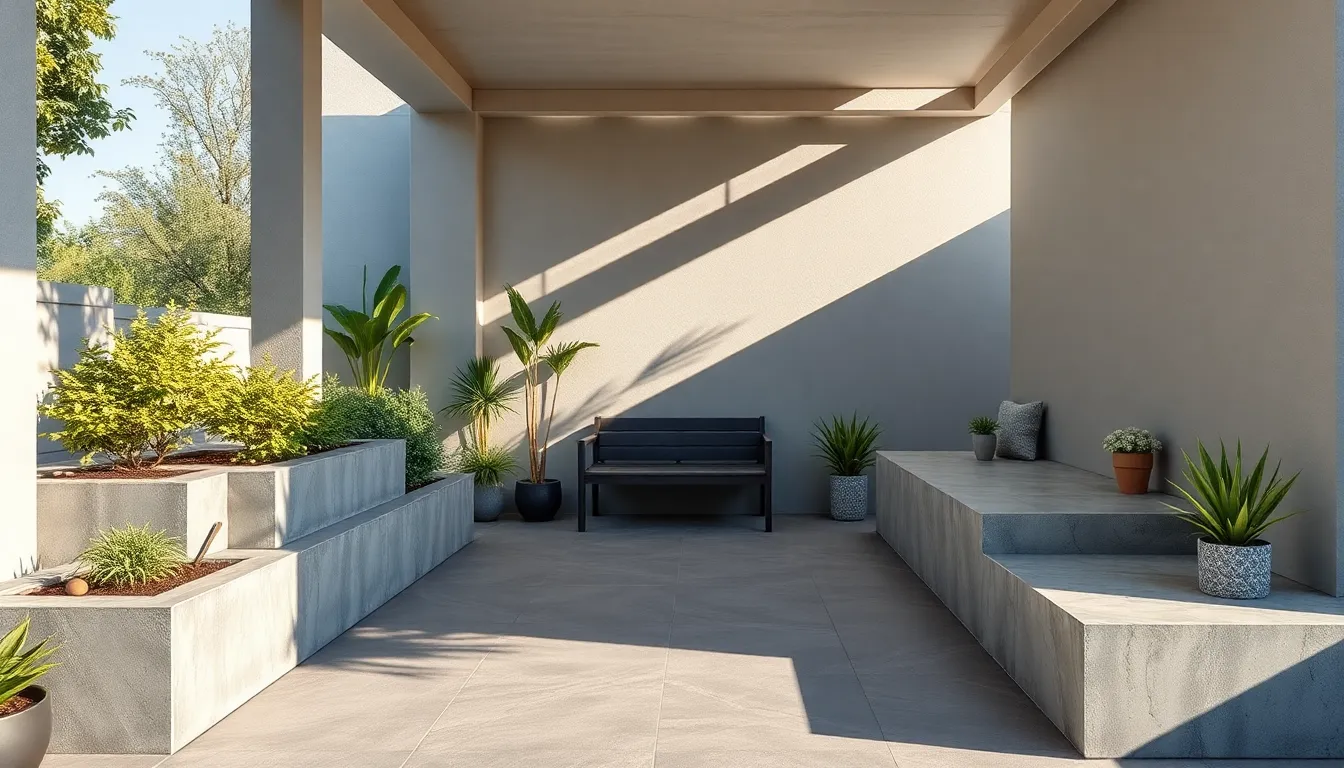
Small concrete porches offer tremendous potential for creating inviting entrances that maximize both style and functionality. We’ll explore targeted design strategies that make compact outdoor spaces feel larger while delivering the visual impact your home deserves.
Compact Entry Designs
Transforming your existing concrete into a cozy entrance requires strategic enhancement techniques that deliver maximum visual impact. Staining and engraving the concrete creates dramatic surface interest while water-based sealers protect your investment without extensive renovation costs. We recommend starting with acid stain applications that penetrate deep into the concrete surface, creating rich color variations that mimic natural stone patterns.
Vertical elements help draw the eye upward in compact spaces, making small porches appear more spacious than their actual dimensions. Consider installing decorative concrete columns or pilasters that frame your entrance while providing structural support for overhead features. These architectural details create depth and visual weight that transforms basic concrete slabs into sophisticated entry statements.
Multi-Level Mini Porches
Tiered concrete designs offer multiple functional zones within minimal square footage, creating visual interest through elevation changes. We suggest incorporating stepped platforms that provide distinct areas for seating, planters, and decorative displays while maintaining seamless concrete continuity. Each level can feature different surface treatments, such as smooth troweled finishes combined with exposed aggregate textures.
Roof extensions protect multi-level porches from weather while creating defined outdoor rooms that feel more substantial. These overhead structures cast interesting shadow patterns across concrete surfaces throughout the day, adding another layer of visual complexity. Consider integrating built-in lighting within the concrete levels to highlight elevation changes during evening hours.
Space-Saving Corner Answers
Corner planters maximize vertical growing space while softening harsh concrete edges with natural greenery. We recommend building concrete planter walls at varying heights to create visual rhythm and accommodate different plant types. These integrated features eliminate the need for separate containers while providing permanent, weather-resistant growing answers.
Compact furniture placement in corner areas requires careful consideration of traffic flow and functional accessibility. Built-in concrete benches that wrap around corners provide seating without protruding into walkways, while small concrete tables can be positioned to serve multiple seating areas. These permanent fixtures withstand weather conditions while maintaining clean lines that complement your porch’s overall design aesthetic.
Budget-Friendly Concrete Porch Projects

Transforming your concrete porch doesn’t require very costly when you focus on strategic improvements that deliver maximum visual impact. We’ll explore cost effective approaches that breathe new life into existing concrete surfaces while maintaining durability and style.
DIY-Friendly Simple Designs
Staining and engraving creates unique patterns on existing concrete without requiring new materials or professional installation. We recommend starting with water-based concrete stains that offer easy application and cleanup while providing rich color variations. Engraving tools allow you to add decorative borders, geometric patterns, or custom designs directly into the concrete surface.
Painted floor treatments offer the most affordable porch makeover option using specialized concrete paints. Sherwin Williams Porch and Floor Enamel eliminates the need for primer application, reducing both material costs and labor time. We suggest choosing colors that complement your home’s exterior while hiding dirt and wear patterns.
String lighting installations add ambiance without expensive electrical work or permanent fixtures. Creating DIY light poles using large planters filled with concrete and wooden posts provides flexible positioning options. Overhead string lights connect between these poles or existing porch structures to create magical evening atmospheres.
Rustic furniture placement transforms empty concrete spaces into functional seating areas using budget friendly pieces. Picnic tables and benches made from reclaimed wood complement concrete textures while providing comfortable gathering spots. We recommend weatherproofing these additions to ensure longevity in outdoor conditions.
Cost-Effective Material Alternatives
Stamped concrete patterns replicate expensive materials like natural stone, brick, or timber at a fraction of replacement costs. These techniques apply textured mats and stamps to fresh concrete overlays, creating authentic looking surfaces. We find that slate and flagstone patterns provide the most convincing stone appearances while wood grain stamps offer realistic timber textures.
Concrete overlay systems refresh deteriorated surfaces without complete porch reconstruction using thin polymer modified toppings. These overlays bond directly to existing concrete, providing new surfaces for decorative treatments. We recommend overlay thicknesses between 1/4 inch and 3/8 inch for optimal durability and cost effectiveness.
Aggregate exposure techniques reveal decorative stones and materials already embedded in existing concrete through careful surface removal. Pressure washing or chemical etching exposes hidden aggregate patterns, creating textured finishes that resemble expensive terrazzo or natural stone. We suggest testing small areas first to determine the best exposure method for your concrete mix.
Low-Maintenance Options
Sealed concrete surfaces protect against weather damage and staining while reducing long term maintenance requirements. Water-based concrete sealers penetrate the surface to provide protection without creating slippery conditions or yellowing over time. We recommend reapplying sealers every 2-3 years to maintain optimal protection levels.
Exposed aggregate finishes combine durability with natural beauty while requiring minimal upkeep compared to other decorative options. These surfaces resist wear, provide excellent traction, and hide dirt and debris naturally. We find that exposed aggregate steps and walkways maintain their appearance longer than smooth concrete alternatives.
Integral color concrete eliminates the need for surface staining or painting by mixing pigments directly into the concrete during installation. This approach ensures color consistency throughout the material thickness, preventing chips or wear from revealing different colored substrates. We suggest earth tone integral colors that complement natural surroundings while maintaining their appearance over decades.
Decorative Concrete Porch Enhancements

Decorative techniques transform plain concrete surfaces into stunning architectural features that rival natural materials. These advanced methods allow us to create unique textures and patterns that enhance both visual appeal and property value.
Acid-Etched Pattern Designs
Acid etching creates intricate surface designs by using acid to dissolve the concrete and develop textured appearances. This chemical process allows us to achieve complex geometric patterns, flowing organic designs, and detailed decorative motifs that aren’t possible with traditional concrete finishing methods.
Professional contractors apply specialized acid answers to freshly finished concrete surfaces, creating controlled reactions that produce varying depths and textures. The process reveals aggregate materials beneath the surface while simultaneously creating artistic patterns that complement your home’s architectural style.
Different acid concentrations produce varying degrees of texture depth, from subtle surface variations to more pronounced relief patterns. We can combine multiple etching techniques within a single porch design to create zones of contrasting texture that define different functional areas.
Pattern templates and stencils guide the acid application process, ensuring precise geometric designs like Celtic knots, Art Deco motifs, or contemporary abstract patterns. These custom designs become permanent features that won’t fade or wear away like painted decorations.
Inlaid Tile and Mosaic Accents
Inlaid tile and mosaic pieces create vibrant focal points within concrete porch surfaces while adding color and texture contrast. Ceramic tiles, natural stone pieces, and glass mosaics become integral parts of the concrete structure rather than surface applications.
Installation requires precise planning during the concrete pouring process, with tile elements positioned before the concrete fully cures. This timing ensures permanent bonding between the decorative elements and the concrete matrix, preventing future separation or shifting.
Mosaic designs range from simple geometric borders to elaborate artistic compositions featuring family crests, nature scenes, or abstract patterns. We can incorporate recycled glass pieces, broken pottery, or specialty tiles to create unique designs that reflect personal style preferences.
Border applications work particularly well for framing porch edges or creating walkway definition lines. These accent strips guide foot traffic while adding visual interest that complements the overall porch design scheme.
Maintenance requirements remain minimal since properly installed inlays become permanent parts of the concrete surface. Regular sealing protects both the concrete and decorative elements from weather damage and staining.
Custom Logo and Design Elements
Custom logos and personalized design elements transform concrete porches into unique expressions of homeowner identity and style. These permanent installations can include family monograms, business logos, decorative crests, or artistic symbols that hold special meaning.
Design possibilities include raised relief patterns, recessed impressions, or contrasting color applications that make logos and symbols clearly visible. We can incorporate company branding for commercial properties or family names and meaningful symbols for residential applications.
Advanced concrete forming techniques allow us to create three dimensional logo elements that extend above or below the main surface level. These sculptural features add dramatic shadow effects and tactile interest that changes throughout the day as lighting conditions shift.
Color integration happens during the concrete mixing process or through subsequent staining applications, ensuring logo elements maintain their appearance over time. Multiple colors can be used within single designs to create detailed emblems and complex artistic compositions.
Professional design services help translate concept sketches into workable concrete forming plans, ensuring that finished results meet expectations while remaining structurally sound. These custom elements become permanent architectural features that increase property value and create memorable first impressions.
Weather-Resistant Concrete Porch Ideas
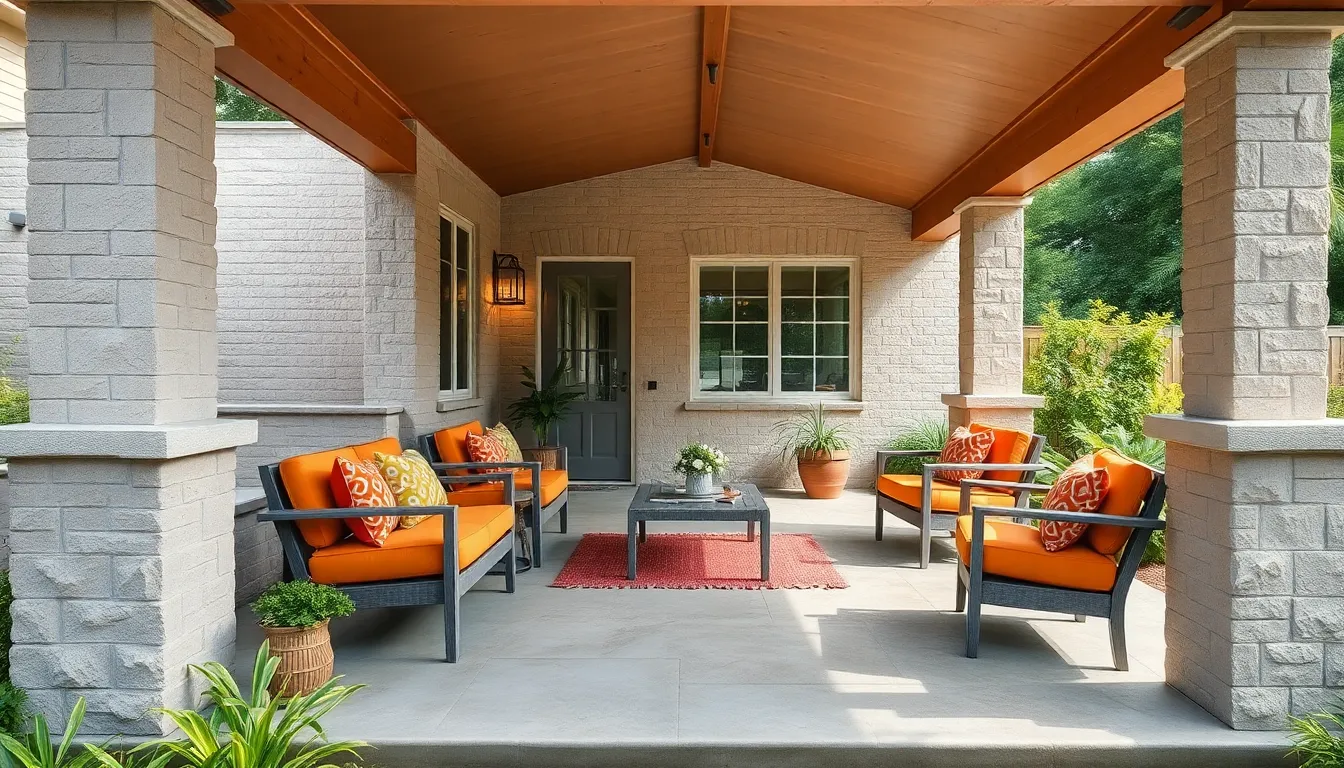
Building a concrete porch that withstands harsh weather conditions requires strategic material choices and design considerations. We’ll explore proven answers that protect your investment while maintaining the stunning aesthetics you’ve worked to create.
Non-Slip Surface Treatments
Polyaspartic flake coatings represent the gold standard for weather resistant porches that prioritize safety. These advanced coatings increase slip resistance by up to 30% while offering exceptional protection against chemicals, UV rays, and daily wear. We can customize these treatments with various colors and flake sizes to match your design vision perfectly.
Exposed aggregate concrete creates naturally textured surfaces by removing the top concrete layer to reveal embedded stones and pebbles. This technique produces beautiful slip resistant surfaces that perform exceptionally well in wet conditions. Professional contractors achieve consistent results by timing the surface removal process precisely during the concrete curing stage.
Broom finished surfaces provide reliable traction through simple texturing techniques applied during concrete placement. We recommend this cost effective option for homeowners seeking dependable slip resistance without complex coating systems. Light broom strokes create subtle texture while heavy applications produce more aggressive traction patterns.
Drainage Integration Answers
Sloped concrete design ensures water flows away from your porch through strategic grade planning during installation. We typically recommend a minimum 1/4 inch drop per foot to achieve proper water runoff without creating noticeable slopes. This fundamental approach prevents water accumulation that leads to freeze thaw damage and surface deterioration.
Drainage channels efficiently direct water away from porch areas through integrated gutter systems and surface drains. These answers work particularly well in regions with heavy rainfall or snow melt conditions. Installing drainage channels during initial construction costs significantly less than retrofitting existing porches.
Permeable concrete options allow water to pass through the surface rather than pooling on top. This innovative approach reduces runoff while preventing ice formation in colder climates. Permeable systems require exact aggregate mixes and installation techniques to maintain structural integrity.
Climate-Exact Design Features
Roof extensions protect porches from direct sunlight and precipitation while creating comfortable outdoor spaces year round. These architectural additions significantly extend the usable life of concrete surfaces by reducing temperature fluctuations and moisture exposure. We often incorporate roof extensions with integrated lighting and ceiling fan mounting points.
Covered porches provide complete weather protection through full enclosure designs that create cozy outdoor rooms. These structures allow you to enjoy your concrete porch regardless of climate conditions while reducing maintenance requirements. Design options range from simple shed roofs to elaborate gabled structures with decorative columns.
Thermal expansion joints accommodate concrete movement caused by temperature changes without creating unsightly cracks. Proper joint placement becomes critical in regions experiencing extreme temperature swings throughout the year. We space these joints every 8 to 12 feet depending on local climate conditions and concrete thickness.
Lighting Integration for Concrete Porches
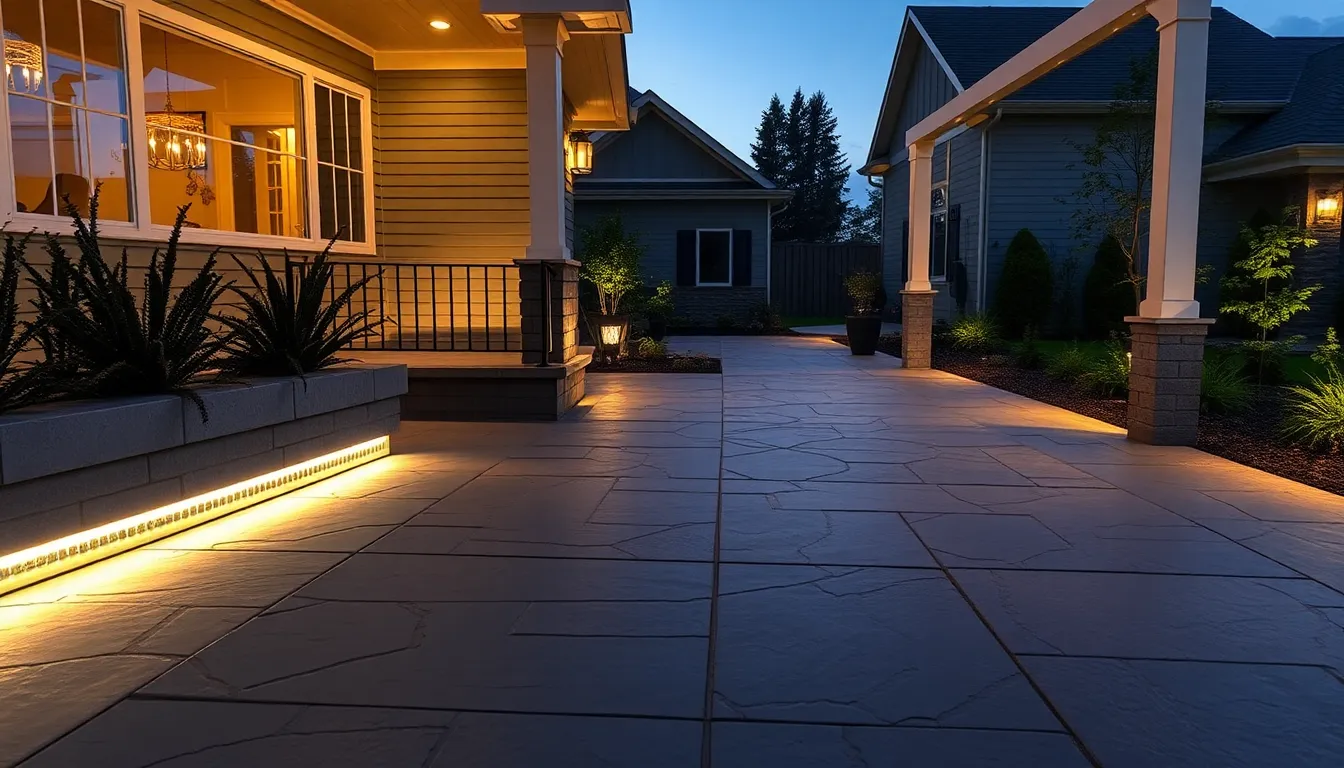
Strategic lighting integration transforms concrete porches into inviting outdoor spaces that showcase architectural features while providing essential functionality. Modern lighting answers complement decorative concrete surfaces while improving safety and extending usable hours.
LED Strip Lighting Options
LED strip installations between large concrete pavers create striking modern aesthetics while providing durable outdoor performance. Our recommended setup includes LED light strips, sand, black rocks, electrical box, PVC fence post, power cord, and spray paint for complete installation. Professional placement ensures weather resistance and optimal light distribution across textured concrete surfaces.
Contemporary LED strip configurations work particularly well with geometric stamped patterns and exposed aggregate finishes. Warm white temperatures complement earth tone stained concrete while cool white options enhance monochromatic color schemes. Strip lighting placement along porch edges defines boundaries and creates dramatic visual impact during evening hours.
Energy efficient LED technology reduces maintenance requirements compared to traditional lighting options. Advanced strip systems offer dimming capabilities and color temperature adjustments to match seasonal preferences. Weather rated components ensure long term performance even though exposure to temperature fluctuations and moisture conditions.
Built-In Post Lighting
Integrated post lighting combines functional illumination with decorative architectural elements throughout concrete porch designs. Support posts accommodate embedded LED fixtures or traditional lighting systems that blend seamlessly with concrete construction. Custom designs incorporate lighting within decorative columns and pillars to create ambient focal points.
Built in post answers eliminate exposed wiring while providing consistent light distribution across porch surfaces. Concrete post construction allows for internal conduit installation during initial construction phases. Modern LED options reduce heat generation and extend fixture lifespan within enclosed concrete environments.
Post lighting configurations work effectively with raised planter walls and integrated seating features. Strategic placement highlights textural concrete finishes while providing task lighting for functional areas. Variable intensity controls allow customization based on exact activities and time requirements.
Ambient Industry Lighting
Perimeter industry lighting enhances concrete porch visibility while showcasing surrounding outdoor features. Strategic placement around porch edges creates layered lighting effects that highlight stamped patterns and decorative borders. Professional installation ensures proper spacing and optimal coverage for safety and aesthetic purposes.
Industry lighting systems complement concrete fixtures including pendant lamps, ceiling lamps, and wall lamps for cohesive design integration. Ground level fixtures can highlight contrasting grout lines and geometric patterns within stamped concrete surfaces. Pathway lighting extends porch functionality into adjacent outdoor living areas.
Timer controls and motion sensors optimize energy efficiency while maintaining security benefits. Industry lighting creates visual continuity between concrete porches and surrounding hardscape elements. Custom DIY concrete lighting fixtures can incorporate ambient industry concepts for unique personalized installations.
Conclusion
We’ve explored countless ways to transform your concrete porch from a simple entrance into a stunning architectural feature. From modern minimalist designs to intricate stamped patterns and vibrant colored finishes there’s truly something for every style preference and budget.
The versatility of concrete continues to amaze us as we’ve seen how it can mimic natural materials while offering superior durability and lower maintenance costs. Whether you’re working with a compact space or planning an elaborate outdoor living area these techniques can help you create the perfect welcome for your home.
Remember that proper planning and professional installation will ensure your concrete porch investment pays dividends for years to come. With the right combination of design elements lighting and weather-resistant features you’ll enjoy an outdoor space that enhances both your home’s curb appeal and your daily living experience.
Frequently Asked Questions
What makes modern concrete porches different from traditional concrete surfaces?
Modern concrete porches go far beyond plain gray slabs. Today’s decorative concrete techniques include stamped patterns that mimic wood, stone, or brick, acid staining for rich colors, and exposed aggregate finishes. These advanced methods transform ordinary concrete into attractive surfaces that resemble premium materials while maintaining concrete’s durability and cost-effectiveness.
How can I make my small concrete porch appear larger?
Maximize small porches using vertical elements like decorative columns to create height illusion. Add visual interest through staining and engraving techniques. Consider multi-level designs to create distinct zones, and incorporate space-saving features like integrated planter walls and built-in benches. These strategies enhance both functionality and visual appeal without requiring additional square footage.
What are the most budget-friendly concrete porch improvements?
DIY-friendly options include staining existing concrete, painted floor treatments, and simple engraving patterns. Add string lighting for ambiance and use rustic furniture for seating. Concrete overlay systems can refresh surfaces without complete reconstruction. These cost-effective solutions deliver maximum visual impact while maintaining durability and style.
How do I choose the right color for my concrete porch?
Earth tone staining creates natural stone appearances through acid staining techniques. For bold statements, consider accent colors with decorative tile inlays. Two-tone combinations using dual staining applications can enhance architectural features. Choose colors that complement your home’s exterior and consider the maintenance requirements of different color treatments.
What built-in features work best for concrete porches?
Integrated planters serve as both decorative elements and functional growing spaces. Built-in concrete benches provide permanent, weather-resistant seating. Decorative columns add architectural interest while supporting porch roofs. These features create seamless design continuity and transform ordinary porches into multifunctional outdoor living spaces.
How can I make my concrete porch weather-resistant?
Use non-slip surface treatments like polyaspartic flake coatings or exposed aggregate finishes for safety. Incorporate proper drainage with sloped designs and drainage channels. Add roof extensions or covered areas for protection. Include thermal expansion joints to accommodate concrete movement in varying temperatures, ensuring long-lasting performance.
What lighting options work best for concrete porches?
LED strip lighting creates modern aesthetics while improving evening safety. Built-in post lighting combines illumination with decorative elements without exposed wiring. Consider ambient lighting with timer controls and motion sensors for energy efficiency. Strategic lighting enhances both functionality and showcases architectural features of your concrete porch design.
Can I add decorative patterns to existing concrete porches?
Yes, existing concrete can be enhanced through acid-etched pattern designs, engraving techniques, and concrete overlay systems. Inlaid tile and mosaic accents create vibrant focal points. Custom logos and design elements can personalize your space. These enhancements transform plain surfaces into stunning architectural features without complete reconstruction.


